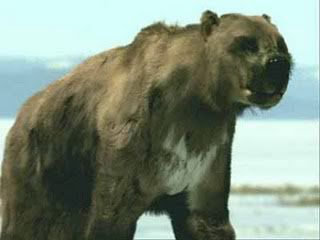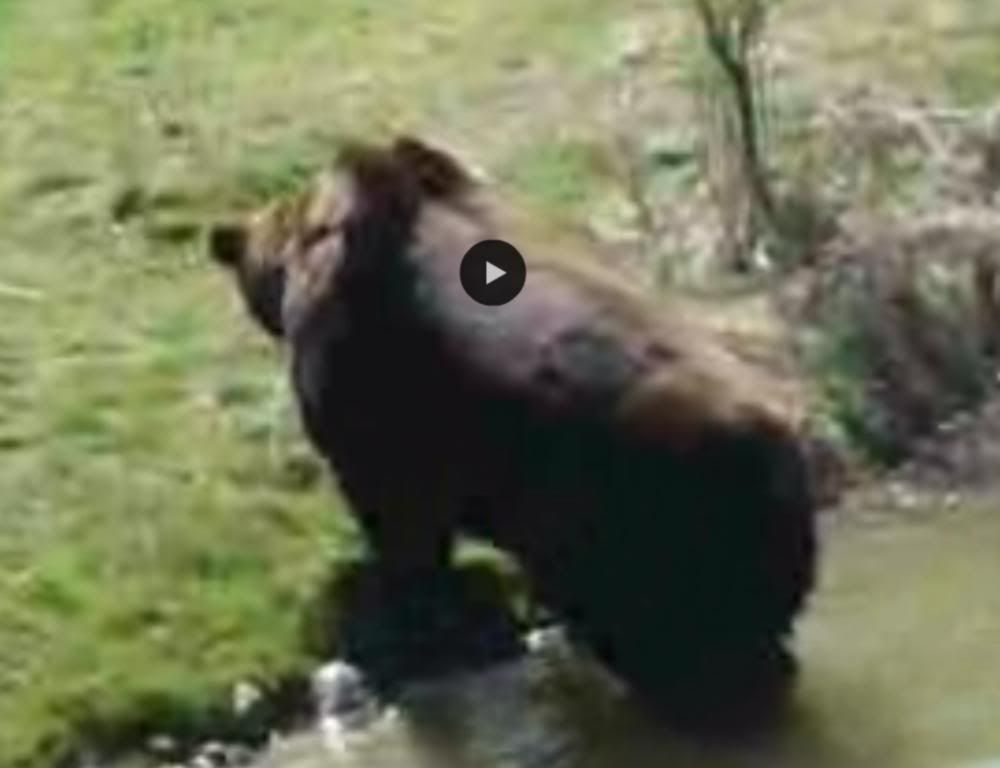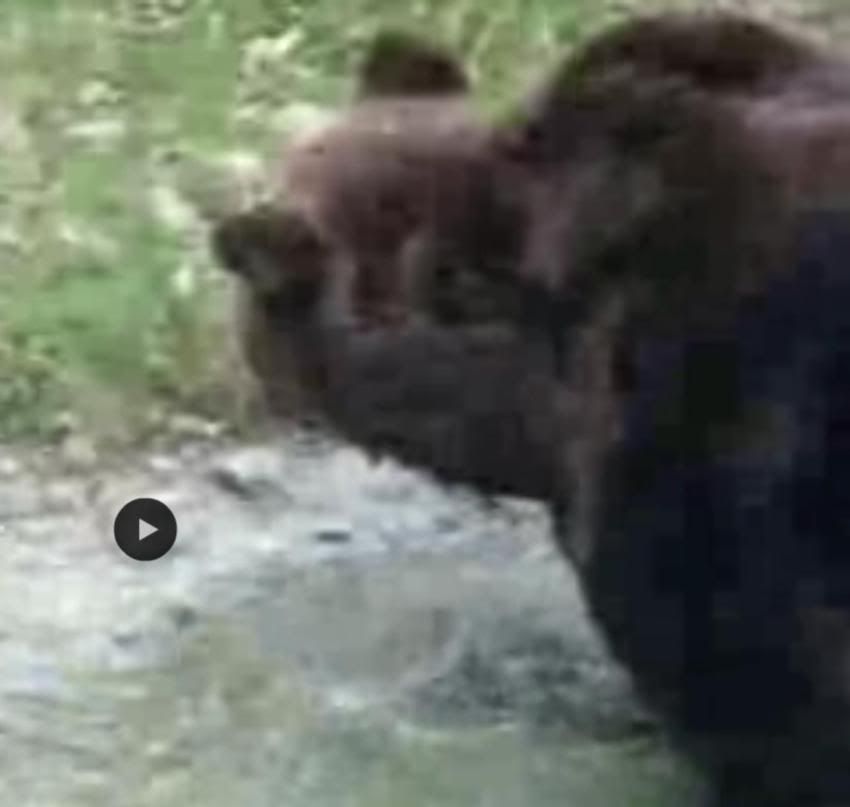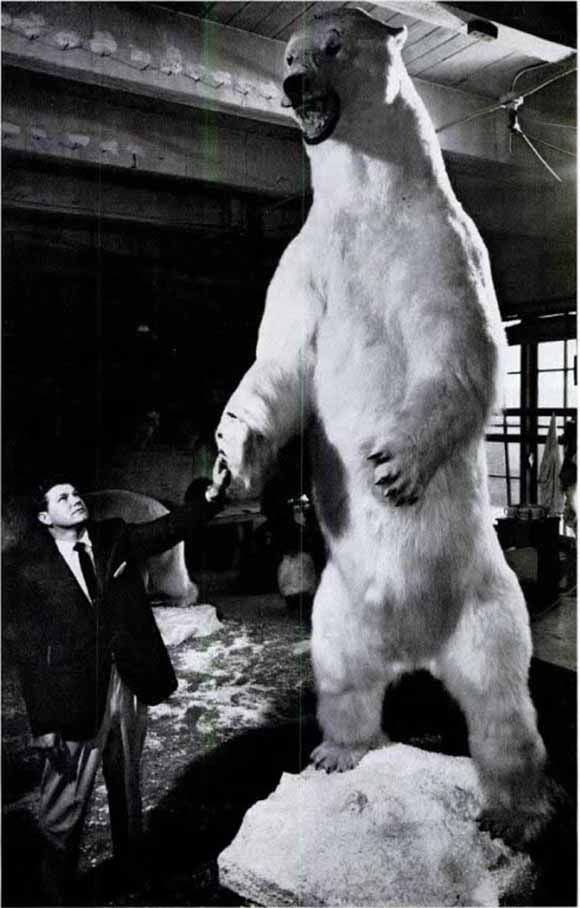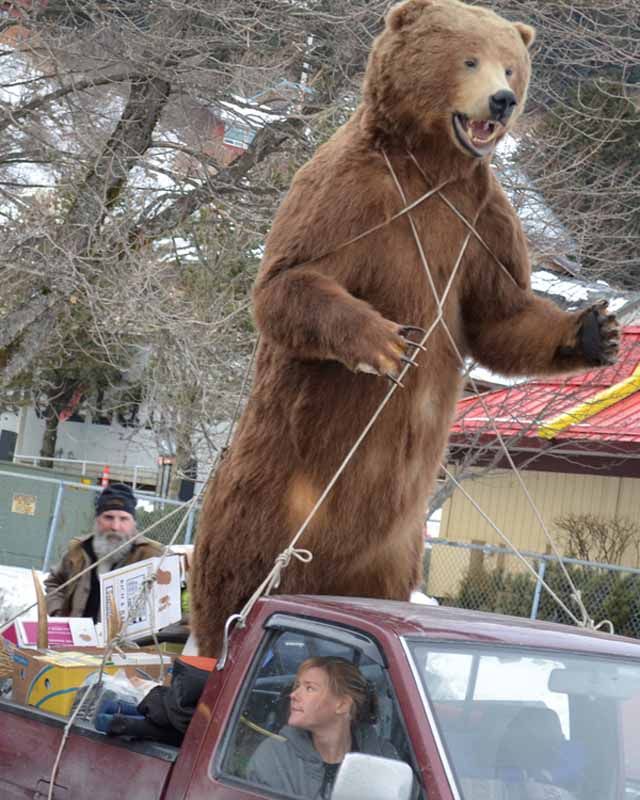|
|
Post by grrraaahhh on Jan 2, 2012 19:51:08 GMT -9
The figure of 1002kg I believe was never confirmed/verified, I don't it actually weighed that much. I understand the skepticism Richard, but I think this bear was likely weighed:  Source: Ellis, Richard, On Thin Ice: The Changing World of the Polar Bear, New York: Vintage Books, 2010. Gerald Woods Text Extract: Sports Illustrated 1961 Text Extract:This fierce new competition has led to some bitter rhubarbs, with Fitz making supreme decisions from his trophy-tilled penthouse in Manhattan. The most recent controversy involved a mammoth polar bear killed by Arthur Dubs of Medford, Ore. Mounted, the bear stands 11 feet 1½ inches, the tallest ever. But Fitz and the B&C Club take the position that bear records are meaningful only if based on the size of the skull. "The taxidermists seem to operate on the principle that what the hunter wants is altitude," Fitz grumbles, "and they mount these bears straight up in a position no polar bear has ever taken. Then they measure the height. And this can vary by as much as a foot or two for the same size skin." One can only pity poor Dubs. He may well have taken the biggest polar bear ever, but he can't even submit the skull for measurement because a piece of it was chipped off in the dressing operation. He is left with a gargantuan trophy totally lacking in official status. Sports Illustrated 1961 Text Extract:This fierce new competition has led to some bitter rhubarbs, with Fitz making supreme decisions from his trophy-tilled penthouse in Manhattan. The most recent controversy involved a mammoth polar bear killed by Arthur Dubs of Medford, Ore. Mounted, the bear stands 11 feet 1½ inches, the tallest ever. But Fitz and the B&C Club take the position that bear records are meaningful only if based on the size of the skull. "The taxidermists seem to operate on the principle that what the hunter wants is altitude," Fitz grumbles, "and they mount these bears straight up in a position no polar bear has ever taken. Then they measure the height. And this can vary by as much as a foot or two for the same size skin." One can only pity poor Dubs. He may well have taken the biggest polar bear ever, but he can't even submit the skull for measurement because a piece of it was chipped off in the dressing operation. He is left with a gargantuan trophy totally lacking in official status. sportsillustrated.cnn.com/vault/article/magazine/MAG1147907/3/index.htm sportsillustrated.cnn.com/vault/article/magazine/MAG1147907/3/index.htmFamous 1961 US media reporting of the polar bear kill:   |
|
|
|
Post by grrraaahhh on Jan 2, 2012 20:05:04 GMT -9
FYI, the English translation of the 1962 Ognev text provided little details.
|
|
|
|
Post by grrraaahhh on Jan 2, 2012 21:19:58 GMT -9
 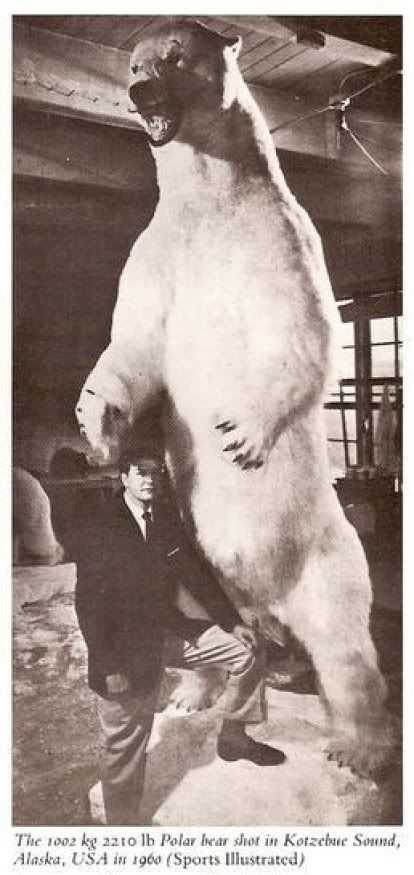 The largest polar bear ever recorded was shot in Kotzebue Sound, Alaska in 1960 weighing a grizzly 1002 kilograms or 2,210 pounds and stood 11 feet 1 1/2 inches 3.39m in height. For analysis, scale Mr. Dubs head and hand to the polar bear's paw. No doubt, this is a BIG bear!
|
|
|
|
Post by warsaw on Jan 23, 2012 13:55:37 GMT -9
|
|
|
|
Post by grrraaahhh on Feb 2, 2012 8:02:39 GMT -9
Brotherbear, between your equipment description and the OP photos, I think the equipment part of your question is more or less answered. Try to remember, biologist have to carry their equipment too. Some areas for example like the open polar north are easier to access (think helicopter) but other areas like dense forest regions are not - here, the risk to [youtube]biologists/conservationists is REAL (lives have been lost). How does one trap a bear? Foot-snare? Tranquilizer? Even if that part is successful then ask yourself (remember the clock is ticking) how many people are needed to weigh a mature grizzly boar 600-800 lbs or a mature Kodiak or Peninsula brown bear who average 1000 lbs? It's not too hard to see why chest girth, paw width, & substitute body mass estimates are made. Moreover, scientist are concerned with other conservation issues; reproductive health, genetic info, blood work, disease, diet, habitat threat, radio collaring the bear, etc. A mature polar bear boar will average about 500 kg - some of the larger polar bears 800 kg plus estimated were too big to weigh even with helicopter assistance. Big inland or mature brownies/grizzlies did not reach their size by being dumb, they are harder to trap and monitor. Camera traps or barb wire hair analysis and their like are popular less invasive ways to study bears. There's a lot more one could say but I think you get the gist. Thank you grrraaahhh.Very vell said.    www.youtube.com/v/xgyqXlr2jSI&hl www.youtube.com/v/xgyqXlr2jSI&hlDr.Djuro Huber (http://djurohuber.ble.pl/) with radiocollared male brown bear with extremely poor dental condition:) .This bear weighed 250 kg and had broken canine tooth. www.ldklek-ogulin.hr/ogrlica-medvjedu-2009.phpThank you Warsaw. A quick topic relating follow up. A lot of people are naturally interested about the weight of brown bears myself included but after awhile of rummaging through the published literature (for relating data, field technical or hunting relating material provide the best morphometric details including weight data) I think people should exercise an open mind. IMO, a better understanding (see relating forum threads/materials) of bear morphology is helpful meaning, cubs, yearlings, sub adult, juveniles, young adults, mature adult, old and senile bears. For example look at the data provided on brown bears. Younger bears and females comprise the majority of field study bears. Adults males often include young adult bears. For adult bears they are categorized as + 65 months old or assigned the ambiguous 'adult' designation. In other reports we see the number of mature specimens (> 12-13 years old) represented often by a handful of bears. Older mature bears are a harder group to study, still, I think many of us would love to examine the morphometric data on all bears > 13 years. Obviously, the more material reviewed the better our understanding becomes but I think the early returns are revealing. Moreover, every time I am watching wildlife documentary film or viewing similar wildlife photos I am always struck when I see how the mature bears are not the ones radio collared or ear tagged rather it is always almost the younger bears and females. I think there are many factors that are in play some of them mentioned in the earlier posts and IMO the anecdotal evidence support these points - they are all factors which should not be marginalized. |
|
|
|
Post by warsaw on Feb 2, 2012 11:55:43 GMT -9
Brotherbear, between your equipment description and the OP photos, I think the equipment part of your question is more or less answered. Try to remember, biologist have to carry their equipment too. Some areas for example like the open polar north are easier to access (think helicopter) but other areas like dense forest regions are not - here, the risk to [youtube]biologists/conservationists is REAL (lives have been lost). How does one trap a bear? Foot-snare? Tranquilizer? Even if that part is successful then ask yourself (remember the clock is ticking) how many people are needed to weigh a mature grizzly boar 600-800 lbs or a mature Kodiak or Peninsula brown bear who average 1000 lbs? It's not too hard to see why chest girth, paw width, & substitute body mass estimates are made. Moreover, scientist are concerned with other conservation issues; reproductive health, genetic info, blood work, disease, diet, habitat threat, radio collaring the bear, etc. A mature polar bear boar will average about 500 kg - some of the larger polar bears 800 kg plus estimated were too big to weigh even with helicopter assistance. Big inland or mature brownies/grizzlies did not reach their size by being dumb, they are harder to trap and monitor. Camera traps or barb wire hair analysis and their like are popular less invasive ways to study bears. There's a lot more one could say but I think you get the gist. Thank you grrraaahhh.Very vell said.    www.youtube.com/v/xgyqXlr2jSI&hl www.youtube.com/v/xgyqXlr2jSI&hlDr.Djuro Huber (http://djurohuber.ble.pl/) with radiocollared male brown bear with extremely poor dental condition:) .This bear weighed 250 kg and had broken canine tooth. www.ldklek-ogulin.hr/ogrlica-medvjedu-2009.phpThank you Warsaw. A quick topic relating follow up. A lot of people are naturally interested about the weight of brown bears myself included but after awhile of rummaging through the published literature (for relating data, field technical or hunting relating material provide the best morphometric details including weight data) I think people should exercise an open mind. IMO, a better understanding (see relating forum threads/materials) of bear morphology is helpful meaning, cubs, yearlings, sub adult, juveniles, young adults, mature adult, old and senile bears. For example look at the data provided on brown bears. Younger bears and females comprise the majority of field study bears. Adults males often include young adult bears. For adult bears they are categorized as + 65 months old or assigned the ambiguous 'adult' designation. In other reports we see the number of mature specimens (> 12-13 years old) represented often by a handful of bears. Older mature bears are a harder group to study, still, I think many of us would love to examine the morphometric data on all bears > 13 years. Obviously, the more material reviewed the better our understanding becomes but I think the early returns are revealing. Moreover, every time I am watching wildlife documentary film or viewing similar wildlife photos I am always struck when I see how the mature bears are not the ones radio collared or ear tagged rather it is always almost the younger bears and females. I think there are many factors that are in play some of them mentioned in the earlier posts and IMO the anecdotal evidence support these points - they are all factors which should not be marginalized. This 250 kg bear was in fairly poor body condition IMO.In fact ,he had no teeth  BTW This starwing shatun with broken canines have much more impressive dentition   |
|
|
|
Post by warsaw on Feb 4, 2012 1:52:42 GMT -9
Here's another similar case:http://www.greatfallstribune.com/article/20110921/NEWS01/109210301/FWP-puts-down-geezer-grizzly-from-Rocky-Mountain-Front  One of the oldest male grizzly bears ever captured in northwest Montana was euthanized Monday after age and poor condition likely led it onto private land to gorge on livestock feed after a quarter century of surviving in the wilderness. The bear, known as "Stanley" or No. 8, was 24 to 27 years old, said Mike Madel, a Choteau-based grizzly bear management specialist with Montana Fish, Wildlife & Parks. That makes it one of the oldest male grizzly bears — if not the oldest — ever captured in the Northern Continental Divide Ecosystem, he said. The NCDE encompasses 9,600 square miles of northwestern Montana, including Glacier National Park, five national forests and four wilderness areas. Males don't often make it past 22 or 23," Madel said. "Twenty is old. The age estimate was based on an analysis of a tooth that was pulled when the grizzly was captured in 2006. The lifespan of male grizzly bears are shorter than females, Madel said. One factor is fierce fights they have with other males, which often lead to serious injury, he said. "This was an old bear," Madel said. On Friday, the geezer grizzly broke into large, landmark barn on Smith Creek ranch south of Augusta. The barn's sliding doors were not set in place at the bottom and the old bear figured out how to swing them open to get in and out. It ate 30 to 50 pounds of livestock feed stored in 55-gallon drums. A culvert trap, baited with the same feed, was set in the barn Saturday and the bear was captured and then euthanized Monday at a Montana Fish, Wildlife & Parks laboratory in Bozeman. One reason for the decision to kill the bear was its advanced age, Madel said. Its molars were worn flat and it scored 2.5 on a 1-to-5 emaciation scale with 1 being the worst. It also had tooth decay. It weighed 429 pounds, which is considered small for a male living on the Rocky Mountain Front. "These bears, when they hit a certain age and their teeth are worn down, they don't have the ability to fend for themselves or forage as easily as they did in their prime age," Madel said The grizzly previously broke into U.S. Forest Service cabins on the Flathead National Forest in 2007 and 2008 and caused severe damage. Those break-ins also factored in the decision to remove the bear from the population, Madel said. Under bear management guidelines, female grizzlies are given three chances before they are removed from the population for conflicts. Males are given one or two. Old bears can be removed after the first offense. Researchers first identified the grizzly as Stanley in a 2004 population estimate study in which grizzlies left behind their DNA in hairs left at collection sites. In 2006, Stanley was captured in a snare in the Scapegoat Wilderness as part of a separate population trend study. At that time, a microchip with a specific number identifying the bear was placed behind its right ear. It also left behind hair at the 2007-08 cabin break-ins. As a result, bear managers were able to link the barn raid at Augusta and the previous cabin break-ins in the Flathead National Forest to the aging bear. The grizzly was known as a "wilderness bear," spending most of its life in the Scapegoat Wilderness. That probably played a role in the bear's longevity because it reduced potential conflicts with people and livestock, Madel said. When the bear was captured Saturday, it was 10 to 12 miles east of its previous eastern-most excursion, Madel said. Age and poor health probably prompted it to leave its usual wilderness habitat in search of food. "It's likely he had a hard time chewing on food the way his molars looked," Madel said. Grrraaahhh,this is exactly what I mean: "...Its molars were worn flat ...These bears, when they hit a certain age and their teeth are worn down, they don't have the ability to fend for themselves or forage as easily as they did in their prime age..." |
|
|
|
Post by warsaw on Mar 15, 2012 13:20:35 GMT -9
BTW "...Degenerative joint disease (DJD) and mobility problems DJD is an insidious but significant syndrome, usually developing over a number of years, primarily in aged animals. While it may be a natural consequence of ageing, inflammatory and infectious aetiologies may be involved. Rather than specific lameness, bears with DJD often become less active, sleep more, climb less and are generally slower or more irritable. Stiffness is almost always an indicator of underlying pathology. DJD includes osteoarthritic changes, joint trauma or sepsis and osteo- and spondyloarthropathies. Studies have shown clinical demonstration of osteoarthritic changes in 56% of bears (Fo¨ llmi, 2005) and an incidence of spondyloarthrosis or osteoarthrosis in 27–96% (Kitchener, 2004; Nunn et al., 2007) of bear skeletons of various ages. As populations of captive bears are becoming increasingly geriatric (Kitchener, 2004), we have a responsibility to develop medical and husbandry strategies to meet their requirements, including managing DJD. Joint problems can be minimized by a well-balanced diet, weight monitoring and adequate exercise facilities. Wild bears spend much of their time foraging and climbing. An ideal enclosure should allow these activities; the restrictive captive environments of many bears may contribute to DJD. It is vital that enclosures allow the expression of natural behaviours, to maintain both physical and mental health. Enrichment programmes allow bears to engage in natural behaviours; keeping staff should be encouraged to devise comprehensive and imaginative programmes maximizing the amount of time their bears are active (see also Law & Reid, 2010)..." Source: Veterinary issues related to bears (Ursidae) D. C. BOURNE1, J. M. CRACKNELL2 & H. J. BACON3 1Wildlife Information Network, The Royal Veterinary College, London, United Kingdom, 2Marwell Wildlife, Colden Common, Winchester, United Kingdom, and 3Animals Asia Foundation, Sichuan-Longqiao China Bear Rescue Centre, Longqiao, Xin Du District, Chengdu, Sichuan 610505, China www.animalsasia.org/images/en/download/IntlZooYearBookHeatherBaconReport.pdf |
|
|
|
Post by grrraaahhh on Mar 26, 2012 7:42:44 GMT -9
Remember the earlier comments about the challenges of examining older boars? In line with the theme of the thread; I encourage people to have some fun & examine some of the corresponding morphometric data in the 'Extant/North American' Bears section & look at the data on brown & grizzly bears. Look at the number of bears examined. Look at the differences by age & gender. Remember to look at the time of year information too for example is it spring when the bear is underweight from hibernation, is it mid to latter summer when the bear should be at normal weight, or is it fall time when the bear is adding weight for winter hibernation? As confirmed in other data from other non North American bear populations, morphometric differences are found even in the same area - ecological & dietary dynamics are in the proverbial mix . Of other importance is to look at the corresponding density data. Far from complete, the forum examined North American brown bear technical data make up a limited sampling. For your consideration please look at the following map: 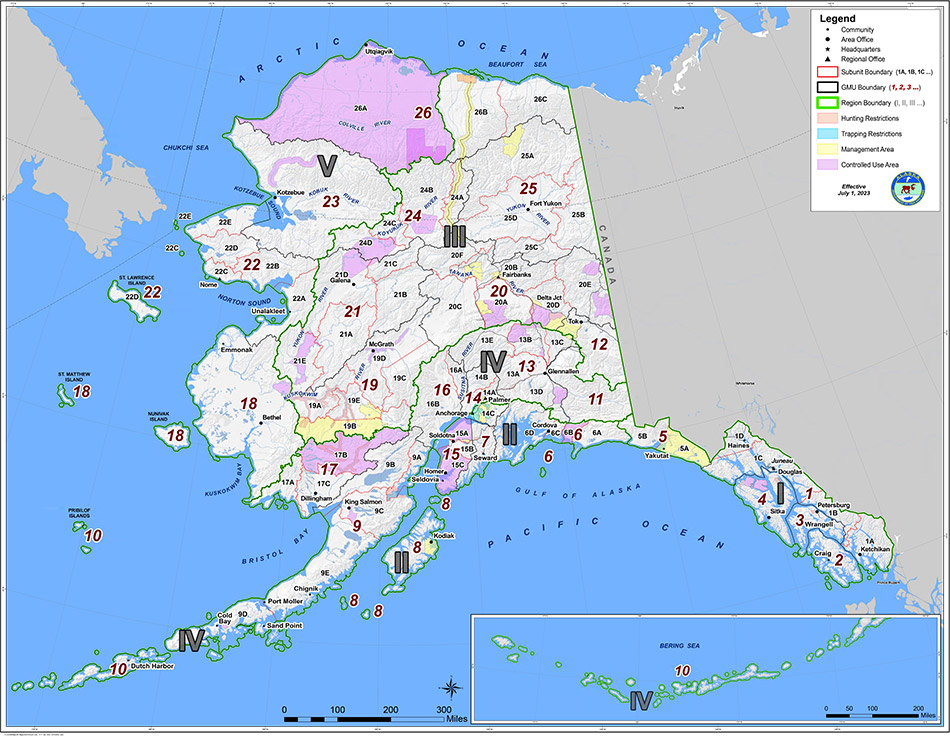 More technical data will be disclosed in the future but from the map in conjunction with density data, the earlier point about finite data is easier understood (also throw in Canada). When examining the technical data, it is helpful (IMHO) to look at a corresponding map for assistance. Of the limited technical or radio collared information, they focus on some of the smaller to smallest brownies found on the continent; that is the most northern & interior of brown bear populations. |
|
|
|
Post by grrraaahhh on Apr 16, 2012 17:09:48 GMT -9
Interior Alaska: Denali National Park
Pat's Big Bear
|
|
|
|
Post by warsaw on May 1, 2012 8:12:17 GMT -9
I have yet to share the data, but I have the ADF&G technical report info showing mature peninsula boar brownies to be averaging 1000 lbs (spring weight). |
|
|
|
Post by warsaw on May 1, 2012 8:21:03 GMT -9
"I have the ADF&G technical report info showing mature peninsula boar brownies to be averaging
1000 lbs (spring weight)."
"Only"441 kg for >= 10 y.o. males (range 363kg-544 kg)
Thanks for data grrraaahhh .
|
|
|
|
Post by grrraaahhh on May 11, 2012 9:35:11 GMT -9
"I have the ADF&G technical report info showing mature peninsula boar brownies to be averaging 1000 lbs (spring weight)." "Only"441 kg for >= 10 y.o. males (range 363kg-544 kg) Thanks for data grrraaahhh . As noted earlier, similar weight data is found for older/mature Kodiak bears. Just to fill in people, forum plans are to extensively examine Kodiak & Peninsula brown bear data including morphological info. There's a lot of material to organize and process so the data coming out will be staggered but ongoing. How to present/package the data is being decided. The hope is to get something started shortly. On a relating note, forum plans to deeper examine some of the more often cited or popular data on North American grizzly bear weight is also in the works. Why? Because the need & time to do so is overdue. Grrraaahhh ~ |
|
|
|
Post by grrraaahhh on May 18, 2012 16:34:33 GMT -9
The Hazards of Field Work
Kodiak, Island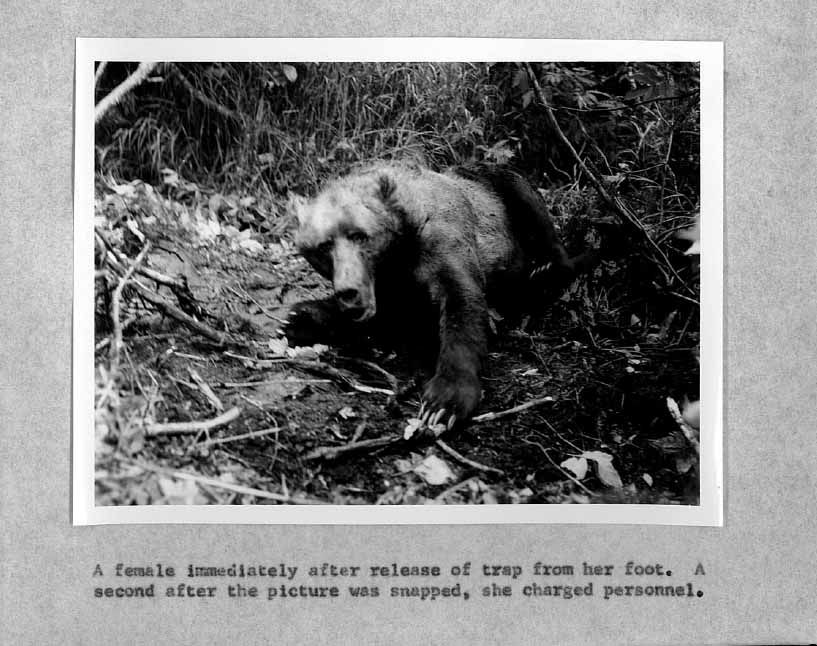 Credit: Troyer, W.A. People should be under no illusion on the dangers of working with large bears.
|
|
|
|
Post by grrraaahhh on May 29, 2012 9:17:08 GMT -9
|
|





